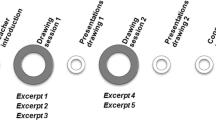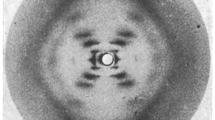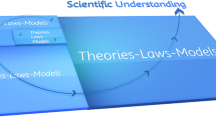Abstract
Most primary school students, although they grasp the scientific concepts of heat convection at the macroscopic level, commonly fail to visualize those concepts. Therefore, our research aims to enact a constructivist teaching sequence (CTS) to restructure students’ visualization changes, ultimately enabling them to synergize macroscopic and sub-microscopic levels of understanding and visual representation. This study has employed a case study, combining qualitative and quantitative data to obtain an in-depth explanation. The quantitative data represent the percentage of the students’ visual representation category and their understanding of pattern changes before and after the intervention. Meanwhile, the ways students presented their thoughts about a concept based on their visual representation are presented via qualitative data. All data come from the participants, comprising 69 fifth-grade elementary school students at one public school in Indonesia. Our research findings show that students’ understanding of heat convection at both macroscopic and sub-microscopic levels improved to scientific conception, after undertaking the learning process using CTS. In addition, the use of CTS fostered a level of visual representation change regarding “construction” that dominated compared with other approaches: students shifted their visual representations from the varying styles of undefined drawing (UD), non-microscopic drawing (NMD), or no drawing (ND), to partial drawing (PD) and scientific drawing (SD).


Similar content being viewed by others
Data Availability
For supporting data can consider the appendixes and can refer to previous article made by author.
References
Anam, R. S., Widodo, A., Sopandi, W., & Wu, H.-K. (2019). Develo** a five-tier diagnostic test to identify students’ misconceptions in science: An example of the heat transfer concepts. Elementary Education Online, 18(3), 1014–1029. https://doi.org/10.17051/ilkonline.2019.609690
Ainsworth, S. (2008). The educational value of multiple-representations when learning complex scientific concepts. In J. K. Gilbert, M. Reiner, & M. Nakhleh (Eds.), Visualization: Theory and practice in science education. Models and modeling in science education (pp. 191–208). Springer. https://doi.org/10.1007/978-1-4020-5267-5_9
Ainsworth, S. (2010). Improving learning by drawing. Proceedings of the 9th International Conference of the Learning Sciences-Volume, 2(c), 167–168.
Ainsworth, S., Prain, V., & Tytler, R. (2011). Drawing to learn in science. Science, 333(5977), 1096–1097. https://doi.org/10.1126/science.1204153
Anderson, G., & Arsenault, N. (1998). Fundamentals of educational research (2nd ed.). Routledge. https://doi.org/10.4324/9780203978221
Bächtold, M. (2013). What do students “construct” according to constructivism in science education? Research in Science Education, 43(6), 2477–2496. https://doi.org/10.1007/s11165-013-9369-7
Banda, A., Mumba, F., Chabalengula, V. M., & Mbewe, S. (2011). Teachers’ understanding of the particulate nature of matter: The case of Zambian pre-service science teachers. Asia-Pacific Forum on Science Learning and Teaching, 12(2), 1–16.
Baviskar, S. N., Todd Hartle, R., & Whitney, T. (2009). Essential criteria to characterize constructivist teaching: Derived from a review of the literature and applied to five constructivist-teaching method articles. International Journal of Science Education, 31(4), 541–550. https://doi.org/10.1080/09500690701731121
Beerenwinkel, A., & von Arx, M. (2017). Constructivism in practice: An exploratory study of teaching patterns and student motivation in physics classrooms in Finland, Germany and Switzerland. Research in Science Education, 47(2), 237–255. https://doi.org/10.1007/s11165-015-9497-3
Boddy, N., Watson, K., & Aubusson, P. (2003). A trial of the five Es: A referent model for constructivist teaching and learning. Research in Science Education, 33(1), 27–42. https://doi.org/10.1023/A:1023606425452
Boz, N., & Boz, Y. (2008). A qualitative case study of prospective chemistry teachers’ knowledge about instructional strategies: Introducing particulate theory. Journal of Science Teacher Education, 19(2), 135–156. https://doi.org/10.1007/s10972-007-9087-y
Chang, W. (2005). Impact of constructivist teaching on students’ beliefs about teaching and learning in introductory physics. Canadian Journal of Science, Mathematics and Technology Education, 5(1), 95–109. https://doi.org/10.1080/14926150509556646
Chi, M. T. H. (2008). Three types of conceptual change: Belief revision, mental model transformation, and categorical shift. In S. Vosniadou (Ed.), Handbook of research on conceptual change (pp. 61–82). Erlbaum.
Chiou, G. L. (2013). Reappraising the relationships between physics students’ mental models and predictions: An example of heat convection. Physical Review Special Topics - Physics Education Research, 9(1), 1–15. https://doi.org/10.1103/PhysRevSTPER.9.010119
Clement, C. A. (2002). Learning with analogies, cases, and computers. Journal of the Learning Sciences, 11(1), 127–138. https://doi.org/10.1207/S15327809JLS1101
Çoruhlu, T. Ş. (2017). Pre-service science teachers ’ conceptions of the “ conduction of heat in solids.” Journal of Baltic Science Education, 16(2), 163–174.
Creswell, J. W., & Plano Clark, V. (2007). Designing and Conducting Mixed Methods Research. Sage.
Dikmenli, M. (2010). Misconceptions of cell division held by student teachers in biology: A drawing analysis. Scientific Research and Essays, 5(2), 235–247. https://doi.org/10.1073/pnas.1306508110
diSessa, A. A., & Sherin, B. L. (1998). What changes in conceptual change? International Journal of Science Education, 20(10), 1155–1191. https://doi.org/10.1080/0950069980201002
Duit, R., Widodo, A., & Wodzinski, C. T. (2007). Conceptual change ideas: Teachers’ views and their instructional practice. In S. Vosniadou, A. Baltas, & X. Vamvakoussi (Eds.), Reframing the conceptual change approach in learning and instruction (pp. 197–217). Elsevier Science.
Einarsdottir, J., Dockett, S., & Perry, B. (2009). Making meaning: Children’s perspectives expressed through drawings. Early Child Development and Care, 179(2), 217–232. https://doi.org/10.1080/03004430802666999
Enyedy, N. (2005). Inventing map**: Creating cultural forms to solve collective problems. Cognition and Instruction, 23(4), 427–466. https://doi.org/10.1207/s1532690xci2304_1
Erickson, G. L. (1979). Children’s conceptions of heat and temperature. Science Education, 63(2), 221–230.
Fiorella, L., & Zhang, Q. (2018). Drawing boundary conditions for learning by drawing. Educational Psychology Review, 30(3), 1115–1137. https://doi.org/10.1007/s10648-018-9444-8
Glynn, S., & Muth, K. D. (2008). Using drawing strategically drawing activities make life science meaningful to third- and fourth-grade students. Science and Children, 45, 48–51.
Guida, A., & Lavielle-Guida, M. (2014). 2011 Space Odyssey: Spatialization as a mechanism to code order allows a close encounter between memory expertise and classic immediate memory studies. Psychological Perspectives on Expertise, 5(573), 176–189. https://doi.org/10.3389/fpsyg.2014.00573
Haney, W., Russell, M., & Bebell, D. (2004). Drawing on education: using drawings to document schooling and support change. Harvard Educational Review, 74(3), 241–272. https://doi.org/10.17763/haer.74.3.w0817u84w7452011
Harrison, A. G., & Treagust, D. F. (2002). The particulate nature of matter: Challenges in understanding the submicroscopic world. Chemical Education: Towards Research-Based Practice, 17, 189–212. https://doi.org/10.1007/0-306-47977-X_9
Iofciu, F., Miron, C., & Antohe, S. (2010). Interactive conceptual maps part of constructivist environment for advanced physics teaching. In Proceedings of The 5th International Conference on Virtual Learning, 1(1), 95–100.
Izquierdo-Aymerich, M., & Adúriz-Bravo, A. (2003). Epistemological foundations of science education. Science & Education, 12(1), 27–43.
Jansoon, N., Coll, R. K., & Somsook, E. (2009). Understanding mental models of dilution in Thai students. International Journal of Environment & Science Education, 4(2), 147–168.
Johnstone, A. H. (1991). Why is science difficult to learn? Things are seldom what they seem. Journal of Computer Assisted Learning, 7, 75–83. https://doi.org/10.1111/j.1365-2729.1991.tb00230.x
Kesidou, S., Duit, R., & Glynn, S. M. (1995). Conceptual development in physics: Students’ understanding of heat. In S. M. Glynn & R. Duit (Eds.), Learning science in the schools: Research reforming practice (pp. 179–198). Erlbaum.
Kozma, R., & Russell, J. (2005). Students becoming chemists: Develo** representational competence. In J. K. Gilbert (Ed.), Visualization in science education. Models and modeling in science education (pp. 121–145). Springer. https://doi.org/10.1007/1-4020-3613-2_8
Krajcik, J. S., & Sutherland, L. M. (2010, April 23). Supporting students in develo** literacy in science. Science, 328, 456–459. https://doi.org/10.1126/science.1182593
Kuo, Y. R., Won, M., Zadnik, M., Siddiqui, S., & Treagust, D. F. (2017). Learning optics with multiple representations: Not as simple as expected. In D. Treagust, R. Duit, & H. Fischer (Eds.), Multiple representations in physics education. Models and modeling in science education (pp. 123–138). Springer. https://doi.org/10.1007/978-3-319-58914-5_6
Lewis, E. L., & Linn, M. C. U. C. B. (1994). Heat energy and temperature concepts of adolescents, adults, and experts. Journal of Research in Science Teaching, 31(6), 657–677. https://doi.org/10.1002/tea.3660310607
Lin, J. W., Yen, M. H., Liang, J. C., Chiu, M. H., & Guo, C. J. (2016). Examining the factors that influence students’ science learning processes and their learning outcomes: 30 years of conceptual change research. Eurasia Journal of Mathematics, Science and Technology Education, 12(9), 2617–2646. https://doi.org/10.12973/eurasia.2016.000600a
Martin, D. J. (2009). Elementary science methods: a constructivist approach (6th ed.). Cengage Learning.
Merino, C., & Sanmartí, N. (2008). How young children model chemical change. Chemistry Education Research and Practice, 9(3), 196–207. https://doi.org/10.1039/b812408f
Nelson, P. G. (2002). Teaching chemistry progressively: From substances, to atoms and molecules, to electrons and nuclei. Chemical Education Research and Practice, 3(2), 215–228. https://doi.org/10.1039/b2rp90017c
Opfermann, M., Schmeck, A., & Fischer, H. E. (2017). Multiple representations in physics and science education – Why should we use them?. In D. Treagust, R. Duit, & H. Fischer (Eds.), Multiple representations in physics education. Models and modeling in science education (pp. 1–22). Springer. https://doi.org/10.1007/978-3-319-58914-5_1
Park, M., Nam, Y., Moore, T., & Roehrig, G. (2011). The impact of integrating engineering into science learning on student’s conceptual understandings of the concept of heat transfer. Journal of the Korean Society of Earth Science Education, 4(2), 89–101.
Posner, G. J., Strike, K. A., Hewson, P. W., & Gertzog, W. A. (1982). Accommodation of a scientific conception: Toward a theory of conceptual change. Science Education, 66(2), 211–227. https://doi.org/10.1002/sce.3730660207
Quillin, K., & Thomas, S. (2015). Drawing-to-learn: A framework for using drawings to promote model-based reasoning in biology. CBE Life Sciences Education, 14(1), 1–16. https://doi.org/10.1187/cbe.14-08-0128
Rau, M. A. (2017). Conditions for the effectiveness of multiple visual representations in enhancing STEM learning. Educational Psychology Review, 29(4), 717–761. https://doi.org/10.1007/s10648-016-9365-3
Rule, A., & Furletti, C. (2004). Using form and function analogy object boxes to teach human body systems. School Science and Mathematics, 104(4), 155–169. https://doi.org/10.1111/j.1949-8594.2004.tb18237.x
Schnittka, C., & Bell, R. (2011). Engineering design and conceptual change in science: Addressing thermal energy and heat transfer in eighth grade. International Journal of Science Education, 33(13), 1861–1887. https://doi.org/10.1080/09500693.2010.529177
Selley, N. J. (2000). Students’ spontaneous use of a particulate model for dissolution. Research in Science Education, 30(4), 389–402. https://doi.org/10.1007/BF02461558
Skamp, K. (Ed.). (1998). Teaching primary science constructively. Harcourt Publishers.
Taber, K. S. (2006). Beyond constructivism: The progressive research programme into learning science. Studies in Science Education, 42(1), 125–184. https://doi.org/10.1080/03057260608560222
Talanquer, V. (2009). On cognitive constraints and learning progressions: The case of “structure of matter.” International Journal of Science Education, 31(15), 2123–2136. https://doi.org/10.1080/09500690802578025
Tang, K. S., Delgado, C., & Moje, E. B. (2014). An integrative framework for the analysis of multiple and multimodal representations for meaning-making in science education. Science Education, 98(2), 305–326. https://doi.org/10.1002/sce.21099
Tekos, G., & Solomonidou, C. (2009). Constructivist learning and teaching of optics concepts using ICT tools in Greek primary school: A pilot study. Journal of Science Education and Technology, 18(5), 415–428. https://doi.org/10.1007/s10956-009-9158-2
Tippett, C. D. (2016). What recent research on diagrams suggests about learning with rather than learning from visual representations in science. International Journal of Science Education, 38(5), 725–746. https://doi.org/10.1080/09500693.2016.1158435
Treagust, D. F., & Chittleborough, G. (2007). The modelling ability of non-major chemistry students and their understanding of the sub-microscopic level. Chemistry Education Research and Practice, 8(3), 274–361.
Treagust, D. F., Chittleborough, G., & Mamiala, T. L. (2003). The role of submicroscopic and symbolic representations in chemical explanations. International Journal of Science Education, 25(11), 1353–1368. https://doi.org/10.1080/0950069032000070306
Tuckey, H., & Selvaratnam, M. (1993). Studies involving three-dimensional visualisation skills in chemistry: A review. Studies in Science Education, 21(1), 99–121. https://doi.org/10.1080/03057269308560015
Van Meter, P., & Garner, J. (2005). The promise and practice of learner-generated drawing: Literature review and synthesis. Educational Psychology Review, 17(4), 285–325. https://doi.org/10.1007/s10648-005-8136-3
Vosniadou, S. (1994). Capturing and modeling the process of conceptual change. Learning and Instruction, 4(1), 45–69. https://doi.org/10.1016/0959-4752(94)90018-3
Widodo, A. (2004). Constructivist oriented lesson: The learning enviroments and the teaching sequance. Peter Lang.
Author information
Authors and Affiliations
Corresponding author
Ethics declarations
Conflict of Interest
The authors declare no competing interests.
Appendices
Appendix 1
Please see Table 7.
Appendix 2. Heat convection question
Question: The main question about the conception.
Fiyya is conducting an experiment by heating water in a clear container which there is contains wood powder. The aim of this experiment is to know how the movement of water is represented by the movement of the wood powder. For more details, look at the picture below!
Macroscopic level
What will happen to that experiment?
-
A.
The closest water with the heat source will rise and the far ones will be above it.
-
B.
The closest water with the heat source will rise and the far ones will replace their positions.
-
C.
The near and far water from the heat source will stay in its position or have no movement at all.
-
D.
If you have your own answer, please write it here.
Sub-microscopic level
Why can it happen in that experiment?
-
A.
The hotter water will have the same arrangement of particles with the cooler one and there are no changes in position in both water conditions.
-
B.
The hotter water will have more dense particles or become heavier than cooler one; therefore, the particles of hot water will go down and cooler water will go up.
-
C.
The hotter water will have more tenuous particles or become lighter than the cooler one, the result hot water will go up and cooler water will go down.
-
D.
If you have your own answer, please write it here.
Visual representation
Based on your explanation, how do you draw the flow and particle of water at points A and B (in the circle provided) in that experiment?
Appendix 3
Please see Table 8.
Appendix 4
Please see Table 9.
Rights and permissions
Springer Nature or its licensor (e.g. a society or other partner) holds exclusive rights to this article under a publishing agreement with the author(s) or other rightsholder(s); author self-archiving of the accepted manuscript version of this article is solely governed by the terms of such publishing agreement and applicable law.
About this article
Cite this article
Anam, R.S., Gumilar, S. & Widodo, A. The Use of the Constructivist Teaching Sequence (CTS) to Facilitate Changes in the Visual Representations of Fifth-Grade Elementary School Students: A Case Study on Teaching Heat Convection Concepts. Int J of Sci and Math Educ 22, 73–99 (2024). https://doi.org/10.1007/s10763-023-10358-x
Received:
Accepted:
Published:
Issue Date:
DOI: https://doi.org/10.1007/s10763-023-10358-x




